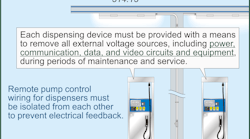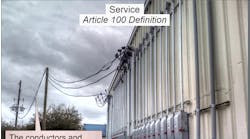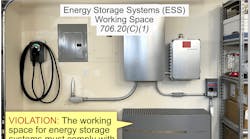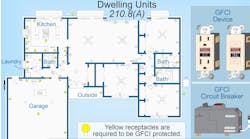The first four chapters of the NEC apply to all installations. Chapter 5 applies to special types of occupancies, and it amends or replaces the requirements of Chapters 1 through 4. After providing the requirements for hazardous locations in Articles 500 through 506, the NEC skips to Art. 510. It then begins a sequence of articles (ending with Art. 517), and moves on to a second sequence (Art. 518 through 525).
The sequence that starts with Art. 518 provides requirements for specific types of occupancies where people assemble (typically in large numbers). But what do Articles 510 through 517 have in common? They are specific types of places where vapors or gases might ignite. Whether it’s a garage dispensing fuel or a hospital dispensing flammable anesthetic, that’s the common thread found in these Articles.
Motor Fuel Dispensing Facilities
Article 514 provides the requirements for facilities where vehicles are fueled from storage tanks. A single, large table takes up about half of Art. 514. This table doesn’t provide any electrical requirements, list any electrical specifications, or address any electrical equipment. What it does tell you is how to classify a motor fuel dispensing area based on the equipment contained therein. The rest of this Article contains specific provisions and refers to other Articles that must be applied.
Vapors from flammable and combustible liquid will ignite when heated to the correct temperature (at the correct volatile mixture). This type of ignition can occur from circuits that most users of electricity consider “safe,” such as a Class 2 power-limited circuit. While a Class 2 circuit is safe from an electrical shock and fire perspective, it’s still capable of igniting the vapors in the environment of a Class I location, such as those in fuel dispensing areas.
Section 514.11 now clarifies that all circuits to the dispensing equipment in fuel dispensing facilities must have a means to disconnect them from their power supply — regardless of the voltage. In an effort to isolate the dispensing equipment from any voltage sources present, the NEC has long required a disconnect located remotely from the dispensing devices to disconnect all circuit conductors, including the neutral, simultaneously from the source of supply [514.11]. This requirement includes low-voltage and limited-energy circuits, such as data and communications, but that fact wasn’t clear in previous editions of the Code. With the 2011 NEC, this requirement becomes quite clear: Each dispensing device shall be provided with a means to remove all external voltage sources, including power, communications, data, and video circuits and including feedback, during periods of maintenance and service of the dispensing equipment [514.13], as shown in Fig. 1 (click here to see Fig. 1).
Health Care Facilities
Article 517 focuses on those parts of health care facilities where patients are examined and treated. Whether those facilities are permanent or movable, they fall under this Article. However, Art. 517 wiring and protection requirements don’t apply to areas such as business offices, patient sleeping areas, or waiting rooms. They don’t apply to animal veterinary facilities either.
Patient care areas include patient rooms as well as examining rooms, therapy areas, treatment rooms, and some patient corridors. They do not include business offices, corridors, lounges, day rooms, dining rooms, or similar areas not classified as patient care areas [517.2].
In patient care areas, do you bond metal boxes containing receptacles, using the insulated equipment grounding conductor? With the 2011 revision, 517.13(B) clearly answers “yes.” This section also includes a change to clarify the sizing of equipment bonding jumpers [517.13(B)(2)]. Although it was obvious to most NEC users that you size equipment bonding jumpers the same as equipment grounding conductors in these areas, technically the sizing wasn’t addressed. This change eliminates that oversight (click here to see Fig. 2).
Receptacles with insulated grounding terminals (isolated ground receptacles) are no longer allowed in a patient care area [517.16], as shown in Fig. 3 (click here to see Fig. 3). What’s the reason for this rather substantial change? The wiring method in these locations requires two equipment grounding conductors: one of the wiring method type; the other in the form of an insulated green conductor [517.13]. Using an isolated ground receptacle defeats the entire concept of this dual equipment ground concept by effectively removing the metal wiring method equipment grounding conductor.
In these areas, the patient is often involved in an invasive procedure. That is, the human skin is broken (typically by an incision). When this is the case, the patient is much more vulnerable to electric shock. In fact, current applied directly to the circulatory system of the patient can easily cause death at current levels lower than even a GFCI will protect against.
Previous editions of the NEC included an Informational Note telling the Code user that the use of these
receptacles was a bad idea in these areas. With this change, the Code rule now prohibits the practice altogether.
If electrical noise is the concern, there are many other remedies available. Adding yet another difference of potential via the isolated ground usually makes matters worse. To investigate further, see IEEE-142.
The 2011 Code clarifies that a Class 2 or Class 3 signaling or communications circuit, or a power-limited fire alarm circuit, need not comply with some of the requirements of Art. 517 [517.80]. These requirements include protection by a raceway system, using an insulated equipment grounding conductor, and protection from physical damage like the circuits of the emergency system.
However, the new wording leaves some confusion regarding the rules for communications circuits, because they aren’t classified as Class 2 or Class 3 — they’re just “communications circuits.” Additionally, the Informational Note regarding nonelectrical equipment was deleted.
In other than patient care areas, the installation of communications and signaling systems must be in accordance with Chapter 7 and Chapter 8 as applicable [517.81].
Assembly Occupancies
When does Art. 518 apply? When a building or portion of it is specifically designed or intended for the assembly of 100 or more people. Article 518 goes out of its way to eliminate any confusion about the occupancies to which it applies by listing 19 examples [518.2].
It’s much harder to evacuate 100 or more people from a burning building than to evacuate just a few. That concept underlies much of the reasoning behind the requirements of this article.
What’s changed with the 2011 Code is that 518.3(B) is much clearer about the rules for GFCIs in temporary installations in assembly occupancies. This section allows for receptacles that aren’t GFCI protected in exhibition halls, which are typically a venue for trade shows, by following the rules of Art. 590 for temporary installations (except for the GFCI requirements of 590.6). However, some Code users have read this as allowing the GFCI protection requirements of 210.8 (for example) to be waived by this section. Section 90.3 clearly requires that the rules of Chapters 1 through 4 of the NEC apply except where amended by Chapters 5, 6, and 7 for the particular conditions. This means that the GFCI protection requirements of 210.8 apply to installations made under Chapter 5 unless specifically amended. Art. 518 does not make any such amendment.
Consider a kitchen trade show, for example. If the sinks are functional, that fact kicks 210.8 into play, and some of the countertop receptacles require GFCI protection. Nothing in 518.3 waives that requirement [90.3], and there is no Code basis for leaving the countertop receptacles near those sinks unprotected. To prevent erroneously applying an exception to an obvious requirement, the 2011 revision is now explicit about this.
Carnivals
Article 525 covers the installation of portable wiring and equipment for carnivals, circuses, exhibitions, fairs, traveling attractions, and similar functions [525.1]. At first glance, a couple of questions arise. “Aren’t these just like assembly occupancies? Why do we need Art. 525 if Art. 518 covers the same thing?”
Yes, these locations are similar to assembly occupancies [Art. 518], but they are not the same. In fact, there are two big differences:
- Article 518 occupancies are not temporary; Art. 525 occupancies are.
- Article 518 doesn’t cover amusement rides and attractions; Art. 525 does.
You may want to compare these two Articles to see if you can spot other similarities and differences between them. Doing so will help you understand both Articles better.
The disconnecting means requirements discussed in 525.21(A) were revised to correlate with the new term “lockable disconnect.” However, the term “lockable disconnect” wasn’t added to the Code. Although this change was intended to be accepted only if the new term was added to the NEC, the term somehow found its way into this section.
Section 525.23 was changed in a previous Code edition to help make the requirements for GFCI protection in carnivals, circuses, and fairs easier to understand. Although the resulting text was easier to read and understand, there was one glaring problem — the language left this section without any enforceable requirements. The 2011 version of the NEC creates a rule in the opening statement of the section, requiring GFCI protection in the areas discussed. In addition, the requirement was reorganized to make a more logical and consistent NEC rule.
GFCI protection is required for nearly all receptacles in carnivals, circuses, and fairs (click here to see Fig. 4). One application that is afforded a more relaxed GFCI protection requirement is the use of receptacles for quick disconnecting and reconnecting of electrical equipment, provided the receptacles are of the locking type.
The 2011 NEC now requires these receptacles to be high enough in elevation that they aren’t accessible from grade level. Considering that these receptacles are only for “quick” interchange, it leaves some people wondering if this allowance really serves any purpose. If a ladder is required to get to the receptacle, is that still a “quick” interchange?
Core Issue
It may be argued that one of the core issues for the occupancies covered in Art. 517 through Art. 525 is timely evacuation. Consider these points:
- A patient undergoing a surgical procedure, or confined in a hospital, is not in a position that would allow swift evacuation.
- Evacuating large numbers of people from a theatre, an assembly occupancy, or a location such as a circus, carnival, or fair, where they are unfamiliar with the facilities can become a confusing, disorderly process.
Considerations such as these must be included in the design and installation of the wiring systems of these special occupancies in order to provide a higher level of safety.
Holt is the owner of Mike Holt Enterprises, Inc., Leesburg, Fla. He can be reached at: www.mikeholt.com.



